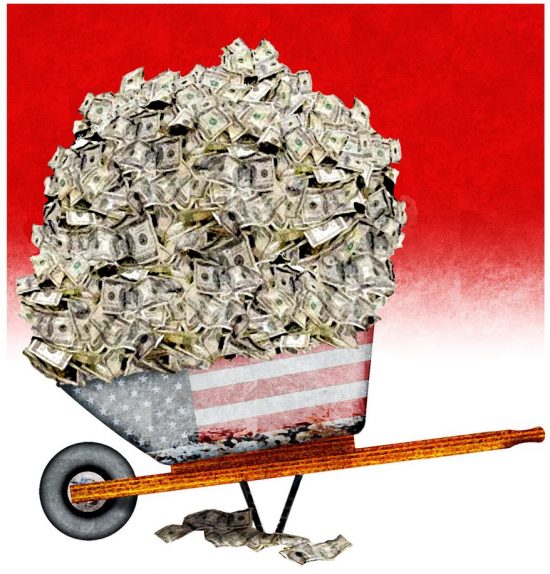Are prices going to soar or are they going to collapse as a result of the ongoing economic chaos? There are economic “experts” making the case for a coming deflation while others argue that a great inflation is coming.
The market does not appear to be very concerned about inflation at the moment, with mortgage rates a bit over 3 percent and long-term U.S. government bonds around 1 percent. At the same time, the money supply is soaring, which normally means future inflation. The following is a simplified explanation of what is happening.
 There has been a huge collapse in both the demand and supply for goods and services. With people locked in their homes and with tens of millions no longer getting paychecks, sellers of goods and services have seen their customer base evaporate. At the same time, with the forced closedown of businesses and the prohibitions of people going to work, goods and services are not being produced.
There has been a huge collapse in both the demand and supply for goods and services. With people locked in their homes and with tens of millions no longer getting paychecks, sellers of goods and services have seen their customer base evaporate. At the same time, with the forced closedown of businesses and the prohibitions of people going to work, goods and services are not being produced.
If consumers were just being denied the ability to shop, while businesses could still produce, there would be a great surplus in goods and services, leading to massive price reductions among suppliers trying to hold onto market share. This process would continue until a sufficient number of producers drop out, bringing supply and demand back into equilibrium, because of businesses’ inability to cover costs. A clear case of the survival of the fittest.
If businesses could no longer supply many goods and services (as often happens with excessive regulation), the shortages would cause suppliers to raise prices until again supply and demand are in equilibrium. At the moment, consumers are experiencing both lower prices for gasoline (because of massive overproduction relative to demand) and higher prices for items like toilet paper and foods with long-shelf lives.
If more prices are declining (in terms of total value) than are rising, then deflation is occurring. The opposite, with more prices rising rather than falling, then we have inflation.
To prevent deflation in an attempt to stem bankruptcies, the government is making very low-cost loans and grants to businesses and individuals in various forms. In fact, almost everyone gets free money because the government does not have the tools to precisely determine who really needs it and who can get by without it — and even if they could, many would view the discrimination as unfair.
Some politicians, mostly Democrats, have proposed giving everyone a sum each month to keep them out of poverty, whether they work or not. The problem is that, if governments give large numbers of people money for not producing, it will discourage work, and there will be too much money chasing too few goods, leading to inflation and/or shortages.
To compound the problem, there are a number of different commonly used definitions of “money,” ranging from M1 (physical cash and demand deposits — aka checking accounts) to Divisia M4, which is a monetary aggregate index. Those responsible for controlling the money supply — the Federal Reserve in the United States — most often focus on M2. Well-regarded economists like Steve Hanke of Johns Hopkins University and Lawrence Goodman, president of the Center for Financial Stability, argue that more attention should be paid to broad measures of money.
Another problem the central bankers need to pay attention to is changes in the velocity of money or the number of times the same money is spent in a year. A stable money supply, where velocity is increasing, may result in inflation, while falling velocity can result in deflation. Forecasting changes in velocity is notoriously difficult.
As is well known, debt levels, particularly government debt levels, are hitting record highs almost everywhere. This year, the U.S. federal government debt will exceed GDP for the first time since World War II. Countries like Japan and Italy are in much worse shape, but that should give no solace. The only way this debt is ever going to be paid back is through some combination of much higher economic growth rates and reduced levels of government spending or the tax of inflation.
Back in the late 1800s and early 1900s, when the world was on the gold standard, governments were constrained in their borrowing because they had to redeem their debts in gold. And the definition of money was clear. At some point, there will be a day of reckoning for the current debt/monetary mess, and the world is likely to go back to commodity-based money as a unit of account — but in an electronic digitized form.
It is not possible to know how much and when deflation or inflation will occur. The variables are too many to measure with precision, let alone knowing what decisions the political class will make. And other black swans like COVID-19 may come along. So, what is a person to do? The answer is to keep part of one’s wealth in claims in real assets (i.e., gold, oil, copper, aluminum) that are highly liquid, which will never go to zero value, in multiple legal jurisdictions.
The scarcity of an asset as contrasted with its usefulness, like gold, becomes irrelevant in an age where everything can be digitally tokenized. Financial entrepreneurs are developing ways to tokenize real assets that can be securely encrypted and traded over the Internet, making the task increasingly easy. Eventually, these private pseudo-monies will gain market share and first supplant monies issued by smaller governments, and finally even the euro, yuan, yen and USD.
https://www.washingtontimes.com/news/2020/may/18/deflation-or-inflation-covid-19-economic-chaos/